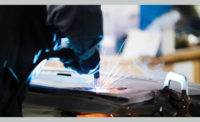7 sins of welding
Avoid the most commonly overlooked dangers

Welding professionals are critical to a wide variety of industries, from the automotive and transportation industries to aerospace, manufacturing, construction and more. At times, no matter the industry where the job is performed, the perils of the occupation can also be quite dangerous. According to OSHA, welding, cutting and brazing activities pose health and safety risks to more than half a million workers in the United States. The risk from fatal injuries alone is more than four deaths per thousand workers over a working lifetime.
Fortunately, following proper safety protocols can drastically improve workplace safety for welders and others on a job site. But for welders who are dealing with a myriad of job responsibilities and daily pressures, it can be easy to forget or forgo these safety practices.
Here are seven hidden dangers in welding that often lead to preventable accidents:
1 Not wearing appropriate personal protective equipment
Wearing PPE is one of the easiest ways to improve safety while welding. PPE should be worn properly and for the entire duration of a welding job – every single time.
Eye protection is particularly important to protect welders from electromagnetic energy given off by an arc or flame. OSHA requires welders to wear safety glasses, goggles or welding helmets with the proper shade lens to protect against flash burn. A shade number indicates the intensity of light radiation that is allowed to pass through a lens. The exact shade lens needed will depend on the type of welding being done, the electrode size and arc current. When in doubt, reference OSHA’s regulations to determine the appropriate shade lens for a job.
Face shields should also be used when the entire face needs protection against flying particles, metal sparks and chemical or biological splash. Even though face shields must meet ANSI Z87.1-1989 standards, they are considered secondary protection and must be used in addition to safety glasses or goggles.
Finally, it’s important to ensure protection from overexposure to hazardous welding fumes and gases. According to the American Welding Society, overexposed welders have a greater chance of developing bronchitis, airway irritation, lung function changes, pneumonia and lung cancer when compared to the general working population. Whenever possible, ventilation systems should be used, but respirators may also be needed to further reduce exposure levels. Respiratory protection options can range from disposable half-face pieces to supplied-air helmets. The best option will depend on the exposure level of the work environment.
2 Wearing improper attire for the job
Arc rays from welding can cause a severe burn similar to sunburn on any exposed skin. Because of this, welders should always dress appropriately for the job in accordance with ANSI Z49.1-2012 standards. This includes:
• dark colored, tightly woven clothing;
• leather sleeves and gauntlet leather welding gloves;
• pants without a cuff; and
• high-top, steel-toed boots.
3 Not considering potential electrical hazards
Another serious welding hazard that is often overlooked is the risk of electrical shock. When welding, a worker will likely come in contact with electrical equipment or metal parts. This contact can cause serious injuries or death from exposure to the high voltage and amperage. To reduce this risk, welders should always wear the proper PPE and comply with a company’s lockout/tag out procedure to disable all machinery and equipment if need be. Taking all equipment to a zero energy level will prevent incidental contact with live electrical sources.
4 Not keeping workspaces tidy
While it may seem trivial, untidy workspaces are actually a leading catalyst for welding injuries. Reduce trip hazards by making sure that all hoses and cables associated with the welding machines and respirators are safely tucked away and not in walking paths. Work cables should be connected as close as possible to the weld area and should not wrap around any workers. All equipment should be properly grounded and installed according to code.
5 Working in unsafe locations
When it comes to ensuring the safety of welders, the location where welding is performed is just as important as any other safety precaution. Before a welding location is established, the work area should be carefully assessed to ensure welding operations will not cause an explosion or create a toxic environment. Worksites should not be set up near any other operations that may produce hazardous fumes.
Extra precautions should be taken when a job requires welding in any confined area. Any confined space should be tested for levels of oxygen, combustible gas and any toxic gases specific to the industry before welding operations begin. Continuous monitoring of the confined space during the entire entry is advised.
6 Failure to use proper fall protection
Because any walking or working surface can be a potential fall hazard, the risk of falls is present at almost every workplace. Approximately 70,000 serious injuries a year result from falls — and more than 11 percent of work-related fatalities in all industries are the result of falls from an elevated position.
So how can welders protect themselves from falls? According to OSHA, anytime a worker is at a height of six feet or more (construction industry) or four feet or more (general industry), the worker must have fall protection equipment. A welder must be attached to a safe anchorage connector, preferably with a shock-absorbing lanyard attached properly to an approved safety harness.
7 Neglecting to protect other employees
Understandably, welding safety precautions are often focused on those who will be performing hazardous operations, but it’s important to take steps to protect other employees who may be in the work area as well. When possible, shade curtains should be used to create a contained area for the welders and to keep all non-welders outside of the active work area.
Reducing risk
While it’s impossible to completely eliminate the risks associated with welding, it is possible to greatly reduce the chance for accidents and injury by following proper safety protocols. Welders — as well as their managers, supervisors and employers — must work together to make safety the number one priority on the worksite, above even productivity and work quality.
Looking for a reprint of this article?
From high-res PDFs to custom plaques, order your copy today!




